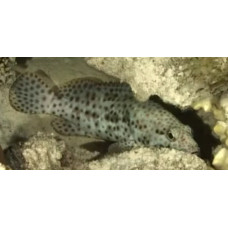Latin name
Epinephelus tauvina
Other name
Arabian grouper or greasy rockcod.
Identification
The body of the greasy grouper is massive, elongated and oval in cross-section. In juveniles it is covered with ctenoid scales, which become cycloid in adults, except for the areas behind and below the pectoral fins. The interorbital space is narrow, flat or slightly concave. Preoperculum rounded, finely serrate, angular serration enlarged. Upper margin of gill cover almost straight. Nostrils almost equal in size, sometimes posteriorly slightly larger. Lower jaw protruding forward. The upper jaw reaches behind the vertical of the posterior eye margin. The lower jaw has 2-5 lateral rows of teeth; the inner teeth on the upper jaw are longer than the fang-like front teeth. There are 8-10 gill rays on the upper part of the gill ray and 17-20 on the lower part. There are 95-112 scale rows along the lateral line. There are 16-18 pyloric appendages.
Features of fish fins
Greasy groupers have a long dorsal fin with 11 hard barbels and 13-16 soft barbels; the third and fourth barbels are slightly longer than the others. Anal fin with 3 hard and 8 soft rays. Pectoral fins with 18-19 rays, longer than the pelvic fins. Caudal fin rounded. Lateral line with 63-74 scales.
Fish colouring
Head and body pale greenish-grey or brown, covered with rounded dark spots ranging from dull orange-red to dark brown, the centres of the spots darker than the edges; the size of the spots on the head gradually decreasing towards the front; a large black spot (or group of black spots) often visible on the body at the base of the last 4 spines of the dorsal fin, extending to the lower part of the fin. 5 faint almost vertical dark stripes may be present on the body, 4 below the dorsal fin and a fifth on the caudal peduncle (these stripes may be represented by dark spots at the base of the dorsal fin and a dark saddle-shaped spot on the caudal peduncle). The fins are also covered with dark spots which become smaller on the pectoral fins and less distinct on the distal part of the fin. The posterior margins of the caudal, anal and pectoral fins are often white-edged. In juveniles, the dark spots on the soft part of the dorsal, caudal and anal fins are so close together that the pale spaces between them form a white net.
Distribution
It occurs in the Red Sea and along the coast of East Africa, east to the Pitcairn archipelago, north to Japan and south to Lord Howe Island. It is not found in Fiji, Tonga or French Polynesia.
Habitat
Benthic marine fish. They live in areas of clear water on coral reefs (down to 50m depth), although juveniles may enter reef shoals, tide pools and mangrove estuaries.
Size
The maximum body length of fish of this species is 100 cm, usually less than 90 cm. Body length is 3.0 to 3.6 times the standard body length (for individuals 10 to 61 cm long). Head length is 2.1 to 2.4 times the standard body length.
Behavior
They are solitary. Juveniles stay close to the shore and tidal pools.
Food and feeding habits
Adults feed mainly on fish (families Holocentridae, Mullidae, Pomacentridae) and sometimes on crustaceans.
Reproduction
Like the majority of representatives of the genus, it is a successive protogynous hermaphrodite. At the beginning of the life cycle all individuals are exclusively female, and only a part of adult fish changes sex and becomes male. Sex change occurs when individuals are 55-75 cm long. Fecundity of females tauvina length 35-62 cm varies from 850 thousand to 2.9 million eggs. Fertilisation is external. Eggs and larvae are pelagic. In the Yaeyama Islands, female tauvinas mature for the first time at the age of 6.7 years with a body length of 37.1 cm (50% of the population). Spawning is observed from March to June. The maximum life expectancy is 23 years.
Fishing
In some regions there is local fishing. They are caught with longlines, traps and harpoons. They are sold fresh.
Relationship with a person
A species of fish harmless to humans.
| Classification | |
| Phylum | Chordata |
| Class | Actinopterygii |
| Squad | Perciformes |
| Family | Serranidae |
| Genus | Epinephelus |
| Species | E. tauvina |
| Features | |
| Conservation status | Data Deficient |
| Habitat | Pelagic |
| Life span, years | 23 |
| Maximum body weight, kg | No information |
| Maximum length, cm | 100 |
| Sailing speed, m/s | No information |
| Threat to people | Edible |
| Way of eating | Predator |
Greasy grouper
Tags: greasy grouper




